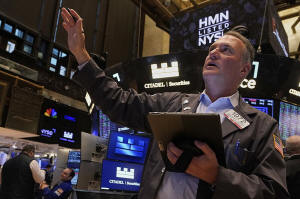Stocks, bonds and the dollar drift after the latest downgrade to the US
government's credit rating
[May 20, 2025] By
STAN CHOE
NEW YORK (AP) — After recovering from an initial jolt, U.S. stocks,
bonds and the value of the U.S. dollar drifted through a quiet Monday
following the latest reminder that the U.S government may be hurtling
toward an unsustainable mountain of debt.
The S&P 500 edged up by 0.1% after Moody’s Ratings became the last of
the three major credit-rating agencies to say the U.S. federal
government no longer deserves a top-tier “Aaa” rating. The Dow Jones
Industrial Average added 137 points, or 0.3%, and the Nasdaq composite
inched up by less than 0.`%.
Moody’s pointed to how the U.S. government continues to borrow more and
more money to pay for its expenses, with political bickering making it
difficult to either rein in Washington’s spending or raise its revenue
in order to get its ballooning debt under more control.
They’re serious problems, but nothing Moody’s said is new, and critics
have been railing against Washington’s inability to control its debt for
many years. Standard & Poor’s lowered its credit rating for the U.S.
government in 2011.
Because the issues are so well known already, investors have likely
already accounted for them, according to Brian Rehling, head of global
fixed income strategy and other analysts at Wells Fargo Investment
Institute. They’re expecting “limited additional market impact”
following the initial reactions to the Moody’s move.

Stocks and U.S. government bond prices at first fell sharply early in
Monday’s trading, but they trimmed their losses as the day progressed.
The S&P 500 went from a loss of 1.1% to a modest gain of 0.2% before
drifting through the afternoon.
The move by Moody’s essentially warns investors globally not to lend to
the U.S. government at such low interest rates, and the yield on the
10-year Treasury briefly jumped above 4.55% early Monday morning. That
number shows how much in interest the U.S. government has to pay in
order to borrow money for 10 years, and it was up sharply from 4.43%
late Friday. But it later regressed to 4.45% as more calm returned to
the market.
The yield on a 30-year Treasury bond briefly leaped above 5% before
likewise receding, up from less than 4% in September.
The downgrade by Moody’s comes ahead of a tense period for Washington,
where it’s set to debate potential cuts in tax rates that could suck
away more revenue, as well as the nation’s limit on how much it can
borrow.
If Washington has to pay more in interest to borrow cash to pay its
bills, that could filter out and cause interest rates to rise for U.S.
households and businesses too, in everything from mortgage rates to auto
loan rates to credit cards. That in turn could slow the economy.
[to top of second column] |

Trader Jonathan Corpina works on the floor of the New York Stock
Exchange, Wednesday, May 14, 2025. (AP Photo/Richard Drew)
 The downgrade adds to a long list of
concerns that have already weighed on the market. Chief among them
is President Donald Trump’s trade war, which itself has forced
investors globally to question whether the U.S. bond market and the
U.S. dollar still deserve their reputations as some of the safest
places to park cash during a crisis.
The U.S. economy seems to be holding up OK so far despite the
pressures of tariffs, and hopes are high that Trump will eventually
relent on his tariffs after striking trade deals with other
countries. That’s a major reason the S&P 500 has rallied back within
3% of its all-time high after falling roughly 20% below that market
last month.
But big companies have been warning recently they’re uncertain about
the future. Walmart, for example, said recently that it will likely
have to raise prices because of tariffs. That caused Trump over the
weekend to criticize Walmart and demand it and China “eat the
tariffs.”
Walmart’s stock slipped 0.1% Monday.
Other big retailers on the schedule to report their latest quarterly
results this upcoming week include Target, Home Depot, Lowe’s and
TJX Cos.
On the winning end of Wall Street was Novavax, which rose 15% after
it said U.S. regulators approved its COVID-19 vaccine under some
conditions. The approval triggered a $175 million milestone payment
under the company’s collaboration agreement with Sanofi.
All told, the S&P 500 rose 5.22 points to 5,963.60. The Dow Jones
Industrial Average added 137.33 to 42,792.07, and the Nasdaq
composite rose 4.36 to 19,215.46.
In stock markets abroad, indexes were mixed amid mostly modest
movements across Europe and Asia.
Indexes were close to flat in both Shanghai and Hong Kong after the
Chinese government said retail sales rose less in April than
expected. Growth in industrial output slowed to 6.1% year-on-year
from 7.7% in March.
In the foreign currency markets, the value of the U.S. dollar fell
against everything from the euro to the Australian dollar.
___
AP Writers Jiang Junzhe and Matt Ott contributed.
All contents © copyright 2025 Associated Press. All rights reserved
 |